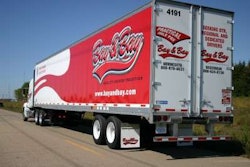In what he called “a down payment on a broader and sustained effort to reduce our dependence on foreign oil,” President Obama on Monday, Jan. 26, directed the U.S. Department of Transportation to establish higher fuel efficiency standards for carmakers’ 2011 model year.
Obama also asked the U.S. Environmental Protection Agency to review whether to grant California and 13 other states the right to impose a 30 percent reduction in vehicle emissions following the Bush administration’s 2007 denial of the request.
“This moment of peril must be turned to one of progress,” Obama said as he signed the two presidential memoranda. “Instead of serving as a partner, Washington stood in their way. … The days of Washington dragging its heels are over.”
The Bush administration on Jan. 7 announced that it would not finalize its rulemaking on Corporate Average Fuel Economy standards. DOT said at the time that the recent financial difficulties of the automobile industry would require the Obama administration to conduct a thorough review of matters affecting the industry. The National Highway Traffic Safety Administration already had done significant work to position U.S. Transportation Secretary Ray LaHood to finalize a rule before the April 1 deadline, DOT said.
“CAFE is a top priority for this administration, and the Department of Transportation and its National Highway Traffic Safety Administration are poised to move quickly on new fuel economy standards for passenger cars and light trucks,” LaHood said.
Under the proposal announced last April 22, fuel efficiency standards for both passenger vehicles and light trucks would increase by 4.5 percent per year over the five-year period ending in 2015 – a 25 percent total improvement that exceeds the 3.3 percent baseline proposed by Congress under the Energy Independence and Security Act of 2007 (EISA).
For passenger cars, the proposal would increase fuel economy from the current 27.5 miles per gallon to 35.7 miles per gallon by 2015. For light trucks, the proposal calls for increases from 23.5 miles per gallon in 2010 to 28.6 miles per gallon in 2015.
All told, the proposal would save nearly 55 billion gallons of fuel and reduce carbon dioxide emissions by 521 million metric tons, while saving America’s drivers more than $100 billion in fuel costs over the lifetime of the vehicles covered by the rule, DOT says.
As required by Congress, the proposed rule would allow automakers to earn credits for exceeding CAFE standards, providing an incentive for companies to exceed these goals while giving manufacturers flexibility to meet the standards without compromising their economic vitality.
Previous EPA Administrator Stephen Johnson, in denying California a waiver to enforce its clean car law in December 2007, said President Bush had just signed a law increasing gas mileage standards for cars and trucks and that a nationwide approach to controlling greenhouse gases was preferable to state-by-state regulation.
The federal Clean Air Act allows California, because of its smog problems, to exceed nationwide air-quality rules if the state obtains a waiver from EPA, which had not denied any of the state’s applications since the law took effect more than 30 years ago. Johnson said California didn’t qualify for a waiver because greenhouse gases were not unique to the state.
California sued the Bush administration on Jan. 2, 2008, over its refusal to grant the waiver; the lawsuit against EPA was joined by 15 other states that had adopted similar laws or were in the process of doing so, along with four environmental organizations.
EPA’s decision was considered a victory for automakers, which had argued that they would have been forced to reduce their selection of vehicles and raise prices in the states that adopted California’s standards. Gov. Arnold Schwarzenegger said federal regulators were “ignoring the will of millions of people who want their government to take action in the fight against global warming.”
California’s law, passed in 2002, established the nation’s first limits on auto emissions of carbon dioxide and other gases that scientists consider to be among the major causes of global warming. The law was scheduled to take effect with the 2009 models and would have required a 30 percent emissions reduction by 2016.
In response to the suits, EPA again cited the new law raising gas mileage requirements. “We now have a more beneficial national approach to a national problem, which establishes an aggressive standard for all 50 states as opposed to a lower standard in California and a patchwork of other states,” said Jonathan Shradar, a spokesman for the federal agency.
California officials said the state’s law actually would require greater fuel efficiency at an earlier date – 2016 instead of the 2020 timetable in the federal law.













